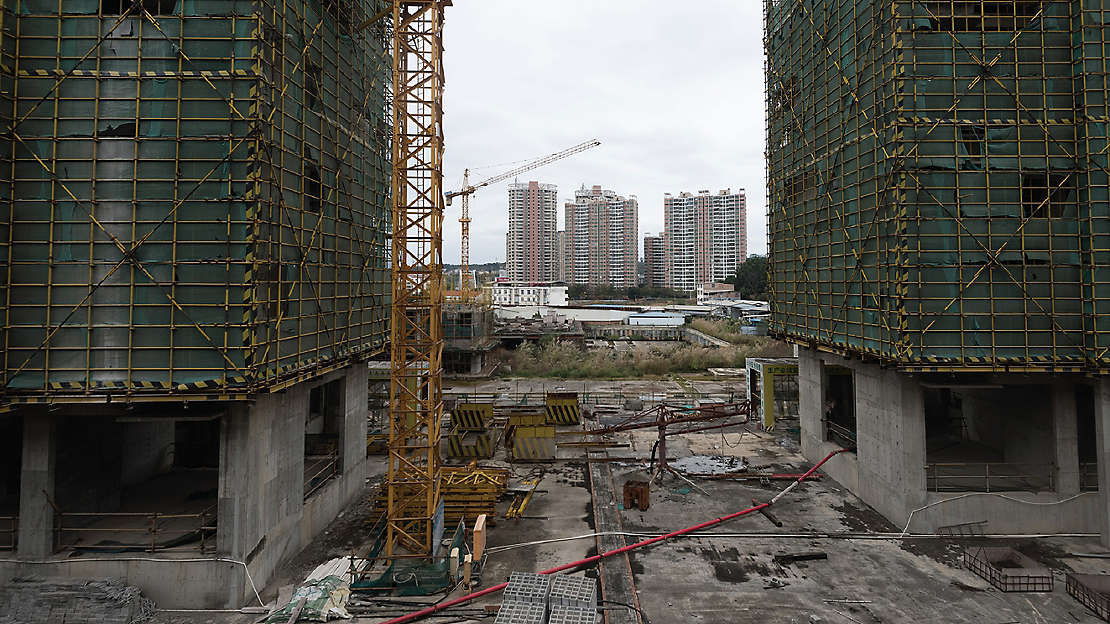When we look at what is driving the trade combativeness, we observe the following:
- China is facing very weak domestic demand,
- The economic policy focus is shifting back to the supply side,
- Manufacturing value add is rising, with consequences for global trade, and
- A possible desire to weaken the exchange rate
Figure 1: Household Final Consumption

Data as of January 1, 2023
Source: World Bank
The Chinese Consumer Is Not Spending
We find scant evidence that the ‘rebalancing towards the consumer’ is happening. In fact the share of household consumption (Figure 1 above) has been falling in recent years from already very low levels if compared internationally. Thus, the economy is becoming more unbalanced. The reasons for this trend are complex, but a rapidly aging population, a deeply entrenched savings culture and the moribund housing market have all likely contributed to record low levels of household consumer confidence.
Strong Growth, But Drivers Are Harder to Pinpoint
China has embarked on an industrial policy focused economic agenda, in a quest to ensure full control of crucial inputs for production. The overall impact of these policies seems to have underpinned real GDP growth more substantially than many analysts had previously expected. The economy grew by 5.3% in real terms in the first quarter of 2024, compared with the same period in 2023. For us this raises the question if we need to shift our focus when analyzing the impact of Chinese economic policy and if so, what kind of framework we should use. With industrial policy objectives taking center stage, surpassing other development goals, using a supply side approach might yield good results. But whilst this approach improves markets’ general understanding, keeping track of the overall impact is harder due to the lower frequency of published data and data quality concerns. Typically demand side economic updates are released monthly or quarterly, while supply side information is either sporadic, private or only available annually.
Figure 2: China Consumer Confidence Plunges

Data as of March 1, 2024
Source: China Economic Monitoring & Analysis Center (CEMAC)
In light of this, we maintain that qualitative assessments have gained in importance, as the leadership in Beijing seeks to gain more independence from western imports for crucial technologies and materials. The impact on specific sectors (such as petrochemicals) or commodities (such as copper) has immediate repercussions for crucial input variables in our research universe far beyond China, and assessing this promptly before infrequently published data becomes available is imperative for investment success. Consequently, we are cautious on the petrochemical sector and issuers based across emerging market regions, while we are constructive on copper producers.
The Consequences of Supply Side Focused Policies
Politically driven and deeply entrenched in the leadership’s belief that self-sufficiency is a goal in and of itself, the policy to insource production has been turbo-charged since Covid, initially targeted at specific industries (e.g. advanced manufacturing, microchips, defense related sectors). However, due to the sheer size of the Chinese economy and without the domestic consumer ready to absorb excess production, global consequences are keenly felt in goods markets everywhere. Simply put, the oversupply needs to find an end-market. Aggressive exporting techniques then create the potential for significant trade related friction. See Figure 3 for an example of a recent announcement by the United States to impose tariffs on Chinese electric vehicles.
Figure 3: US Tariff Announcements
US Set to Impose Tariffs on China EVs, Key Sectors After Review1
China’s Mounting Asia Exports Increase Regional Deflation Rise1

1. Source: Bloomberg
Image used under license with iStock
Exporting oversupply is also often deflationary for recipient countries as discounted prices permeate into their goods markets and could also impair their progress in building out manufacturing capabilities amid stiff Chinese competition. As a result, we are constructive on the outlook for inflation in emerging markets, where many consumers purchase a higher share of goods relative to services compared with consumers in developed markets, which can lead to faster disinflation.
Manufacturing Investment Is Gaining in Importance; Housing Slumps
Supply-side focus in China, particularly the emphasis put on developing advanced manufacturing capabilities, has resulted in an increase in the share of GDP that is derived from the process of making. Its technical term, the share of gross-value-add relative to GDP, has been rising again, reaching 27.7% in its most recent reading.
Figure 4: Manufacturing GVA on the Rise Again

Data as of January 1, 2023. GVA – Gross Value Added
Source: U.S. Bureau of Economic Analysis (BEA), World Bank
Figure 5: China, Urban Investment In Fixed Assets

Data as of March 1, 2024
Source: China National Bureau of Statistics (NBS)
This is considerably higher than for most advanced and emerging economies. The push into advanced manufacturing also has implications for investment flows across different sectors. We detect a clear pattern of divergence, with positive growth in manufacturing and infrastructure while real estate is contracting. This matters greatly for security selection among the vast Chinese credit universe, where we like internationally operating conglomerates while staying away from the imploding Real Estate sector. (See Figure 6).
Figure 6: Abandoned Construction Site in Guilin City, Approximately 300 Miles from Hong Kong

Image used under license with iStock.
Exchange Rate Implications
With Chinese policy aimed at the supply side and manufacturing gaining in terms of the gross-value-add, the simplest route to clear oversupply is to export it. As we saw at the beginning of this note, final consumption as a share of national output is shrinking and consumer confidence is at a low ebb, leaving sales abroad often as the only route for producers. To aid price competitiveness, Chinese policy makers have an incentive to keep the currency competitive. In 2022 for example, the Chinese yuan weakened by 8.5% in nominal terms and in 2023 by approximately 3%. Furthermore, this nominal exchange rate adjustment has combined with very low inflation, resulting in a flatlining of nominal GDP, calculated in US dollars (see Figure 7). Put another way: China has devalued its currency in real terms, fostering a sharp boost to its overall export competitiveness. With current price pressures amid weak domestic demand while inflation globally is still elevated, the much stealthier real depreciation of the Chinese currency will continue to occur in our view, even without a headline-grabbing move for the USD-CNY exchange rate.
Implications and Inference
Chinese macroeconomic policy objectives have shifted to strengthen critical supply chains and insulate the country from dependence on imports from abroad. When this policy leads to oversupply amid weak domestic demand, the scene is set for potential trade conflicts, not just with a potential Trump 2.0 administration but with other international competitors. With a record number of elections in 2024 and populism still on the rise, we believe that protectionism via trade barriers and tariffs will feature often in the offering to voters in developed markets. From the perspective of an emerging market debt portfolio, the impact from the change in policy and a better suited framework will lead to profitable portfolio exposures far beyond Chinese shores, in our view. A comparatively healthy infrastructure and manufacturing investment outlook for example could translate into buoyant markets for raw materials. On the other hand, a glut in petrochemicals produced in China makes us more cautious on the sector across regions.
For investors, understanding the deeper implications of this policy shift will be crucial for investment success. Amid many recent confusing announcements and their sometimes swift reversal, it is easy to digress and focus on the short-term implications on markets. However, Chinese economic policy-making is naturally very long-term in nature and in that sense, perfectly aligned with Xi Jinping’s objective to remain in power, perhaps for decades to come.
Figure 7: Nominal GDP in USD Terms | $TR

Data as of January 1, 2023
Source: China National Bureau of Statistics (NBS), U.S. Bureau of Economic Analysis (BEA), German Federal Statistical Office (Statistisches Bundesamt), Brazilian Institute of Geography & Statistics (IBGE), Indian Ministry of Statistics & Programme Implementation (MoS&PI)
IMPORTANT DISCLOSURE
Availability of this document and products and services provided by MacKay Shields LLC may be limited by applicable laws and regulations in certain jurisdictions and this document is provided only for persons to whom this document and the products and services of MacKay Shields LLC may otherwise lawfully be issued or made available. None of the products and services provided by MacKay Shields LLC are offered to any person in any jurisdiction where such offering would be contrary to local law or regulation. This document is provided for information purposes only. It does not constitute investment or tax advice and should not be construed as an offer to buy securities. The contents of this document have not been reviewed by any regulatory authority in any jurisdiction.
This material contains the opinions of certain professionals at MacKay Shields but not necessarily those of MacKay Shields LLC. The opinions expressed herein are subject to change without notice. This material is distributed for informational purposes only. Forecasts, estimates, and opinions contained herein should not be considered as investment advice or a recommendation of any particular security, strategy or investment product. Information contained herein has been obtained from sources believed to be reliable, but not guaranteed. Any forward-looking statements speak only as of the date they are made and MacKay Shields assumes no duty and does not undertake to update forward-looking statements. No part of this document may be reproduced in any form, or referred to in any other publication, without express written permission of MacKay Shields LLC. ©2024, MacKay Shields LLC. All Rights Reserved.
Information included herein should not be considered predicative of future transactions or commitments made by MacKay Shields LLC nor as an indication of current or future profitability. There is no assurance investment objectives will be met.
Past performance is not indicative of future results.
NOTE TO UK AND EUROPEAN AUDIENCE
This document is intended only for the use of professional investors as defined in the Alternative Investment Fund Manager’s Directive and/or the UK Financial Conduct Authority’s Conduct of Business Sourcebook. To the extent this document has been issued in the United Kingdom, it has been issued by MacKay Shields UK LLP, 80 Coleman Street, London, UK EC2R 5BJ, which is authorised and regulated by the UK Financial Conduct Authority. To the extent this document has been issued in the EEA, it has been issued by MacKay Shields Europe Investment Management Limited, Hamilton House, 28 Fitzwilliam Place, Dublin 2 Ireland, which is authorised and regulated by the Central Bank of Ireland.
NOTE TO CANADIAN AUDIENCE
The information in these materials is not an offer to sell securities or a solicitation of an offer to buy securities in any jurisdiction of Canada. In Canada, any offer or sale of securities or the provision of any advisory or investment fund manager services will be made only in accordance with applicable Canadian securities laws. More specifically, any offer or sale of securities will be made in accordance with applicable exemptions to dealer and investment fund manager registration requirements, as well as under an exemption from the requirement to file a prospectus, and any advice given on securities will be made in reliance on applicable exemptions to adviser registration requirements.
当資料は、一般的な情報提供のみを目的としています。
当資料は、投資助言の提供、有価証券その他の金融商品の売買の勧誘、または取引戦略への参加の提案を意図するものではありません。
また、当資料は、金融商品取引法、投資信託及び投資法人に関する法律または東京証券取引所が規定する上場に関する規則等に基づく開示書類または運用報告書ではありません。New York Life Investment Management Asia Limitedおよびその関係会社は、当資料に記載された情報について正確であることを表明または保証するものではありません。
当資料は、その配布または使用が認められていない国・地域にて提供することを意図したものではありません。
当資料は、機密情報を含み、お客様のみに提供する目的で作成されています。New York Life Investment Management Asia Limitedによる事前の許可がない限り、当資料を配布、複製、転用することはできません。
New York Life Investment Management Asia Limited
金融商品取引業者 登録番号 関東財務局長(金商)第2964 号
一般社団法人日本投資顧問業協会会員
一般社団法人第二種金融商品取引業協会会員
MacKay Shields LLC is a wholly owned subsidiary of New York Life Investment Management Holdings LLC, which is wholly owned by New York Life Insurance Company. "New York Life Investments" is both a service mark, and the common trade name of certain investment advisers affiliated with New York Life Insurance Company. Investments are not guaranteed by New York Life Insurance Company or New York Life Investments.
Subscribe to get MacKay Shields insights delivered to your inbox.
Related Thought Leadership
